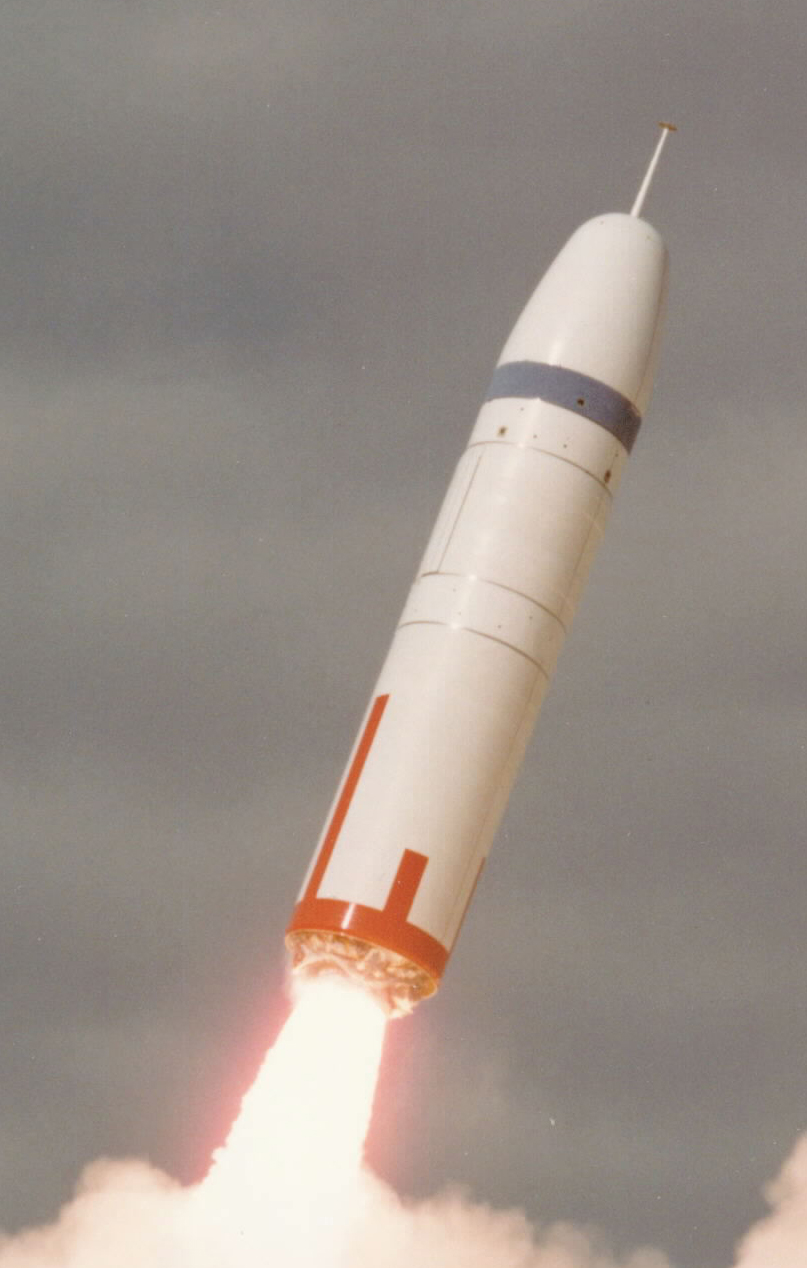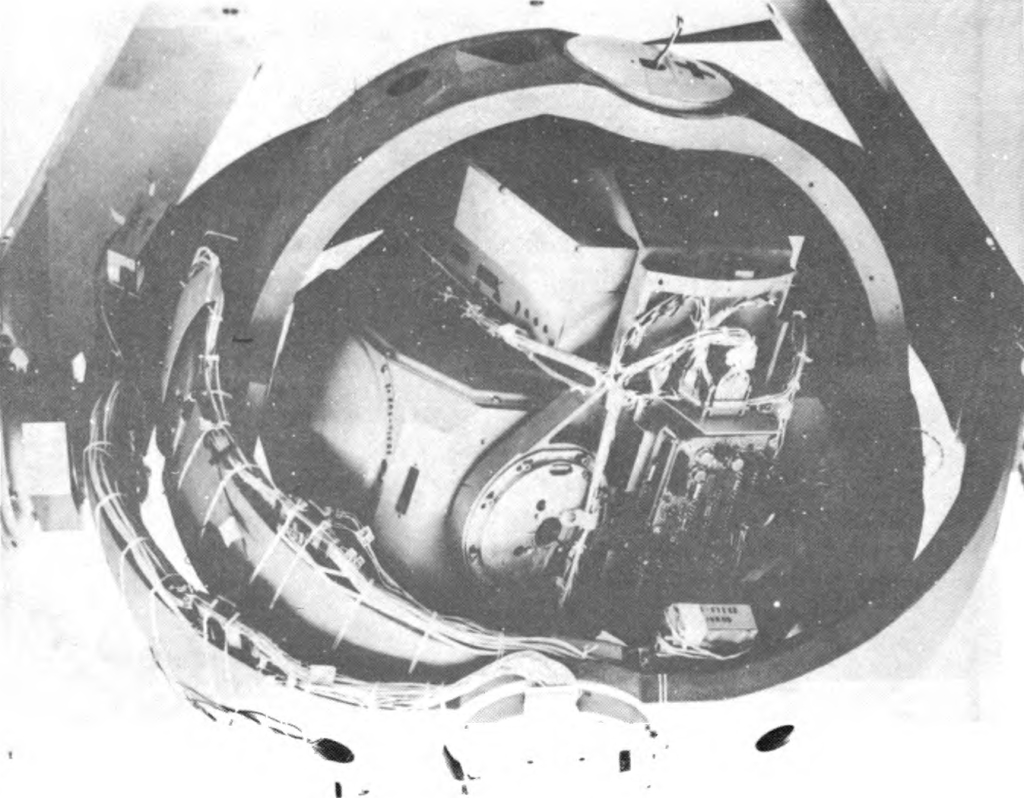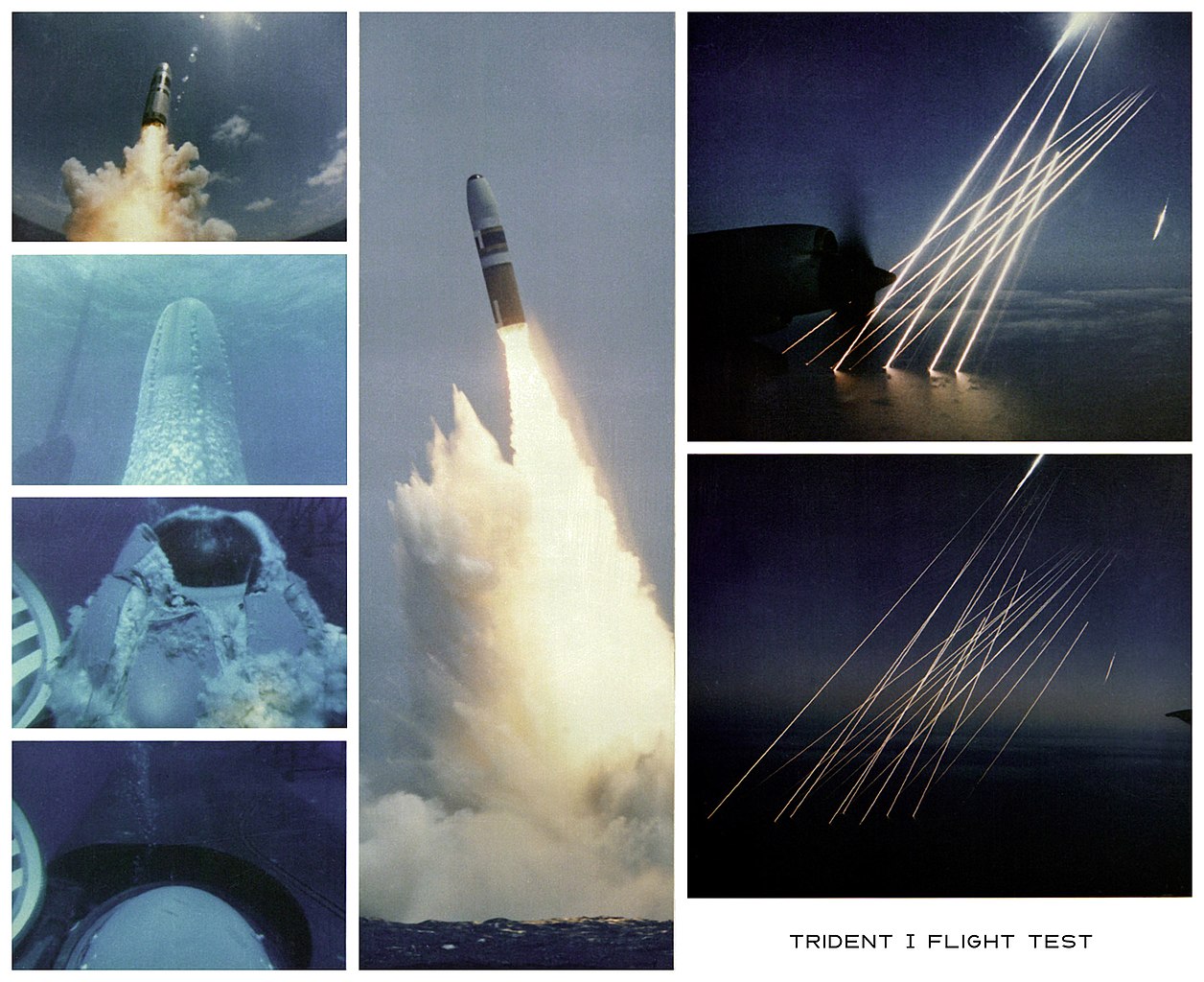Despite the rather tortuous process that led to its authorization, the travails of the Trident I missile continued as the detailed specifications were worked out. The design brief was essentially to maintain the capability of Poseidon in a missile of the same size, but with twice the range to counter potential advances in Soviet ASW. This would require substantial changes in both the design of the missile and the guidance system, changes which proponents of hard-target capability would use to launch an attack on the Air Force's monopoly on the counterforce role.

A Trident C4 demonstrates its aerospike
Getting a range of 4,000 nm out of a missile that had to fit in the same tubes as Poseidon required extensive technical development. A third stage would be needed, and to keep length down, the designers wrapped the bus and warheads around it. This posed a serious problem when it came time to shut down the third stage. The normal strategy of venting the motor would impose unacceptable shocks on the bus, while flying the motor out the front would bathe it in rocket exhaust. An ingenious solution was found that removed the need for thrust termination. The guidance system was programmed to fly the missile on a trajectory that would use up all of the fuel in the third stage. The motor would then be ejected at 1 G, which allowed the ejection system to be tested on the ground instead of in flight, and the bus could begin releasing its warheads. The third stage required an extremely blunt nose, which would normally have increased drag when low in the atmosphere, and the designers came up with another solution, the aerospike. This was a rod that protruded from the nose on launch, and essentially tricked the air into acting like the nose was much longer than it was, giving an extra 300 miles of range.
But even with the aerospike, the third stage alone wasn't enough to achieve the increased range, and truly heroic measures were taken to shed weight, particularly in the bus, where it would have the biggest impact. This meant extensive use of graphite-epoxy composites, very recently developed, and even a decision to accept certain vibration modes which would decrease accuracy in the name of saving weight. The traditional solid propellant divert system was modified to be able to operate at low pressure most of the time, and high pressure when needed for full thrust. Weight reductions were also made in the lower stages, with the use of kevlar for the motor casings, although plans for higher-energy motors had to be scaled back after one exploded during a test. These problems, and issues with the electronics, eventually led to an 11-month delay in service entry.

A W76 in an RV
Initially, the plan had been to reuse the Mk 3 reentry vehicle and W68 warhead from Poseidon, but this was opposed by many who wanted something bigger than the 40 kT warhead used on the earlier missile. Proposals for a really big warhead were thwarted by the placement of the third stage, which limited the biggest warhead that could be accommodated, but the weapons labs in particular were strongly opposed to deploying a new missile without a new warhead. They got their way, and Los Alamos designed the 100 kT W76, which was fitted with a new reentry vehicle. The Mk 3 hadn't quite been able to handle the heat of all of the possible trajectories provided by the new missile, and the new Mk 4 RV would also have a higher ballistic coefficient, allowing it to move through the atmosphere faster and with less dispersion. The greater range of Trident I meant that there was less concern about ABM taking out multiple warheads at once, and countermeasures were limited to making sure that the missile was compatible with a second RV, the Mk 500 Evader. Unlike previous RVs, this would use aerodynamic lift to fly preprogrammed maneuvers within the atmosphere, hopefully making it harder to shoot down. It was never deployed, but it did play a useful role in the development of the Mk 4, which could be optimized for light weight at a cost of making it harder to build decoys that looked like it.
Trident I also introduced a new guidance system, stellar-inertial guidance. This held the potential for greatly improved accuracy and thus hard-target capability, although it was justified on the grounds that the missile needed to be as accurate from 4,000 nm as Poseidon was from 2,000 nm, and needed to be able to go for 30 days between position updates for fear of being detected by the Soviets. Many wanted to just update the existing Poseidon guidance, but the Undersecretary of Defense for Strategic Systems had previously been an engineer developing stellar-inertial systems, and made sure that they were included in the spec.

A Trident I guidance unit
The idea of navigating by the stars was centuries old, but certain practical problems had prevented it from being applied on missiles before Trident. The biggest was the complexity involved in taking multiple star sightings, which engineers at Kearfott realized wasn't necessary. For instance, if the target was at the North Pole, a sighting on Polaris would allow for correction of any errors in latitude or azimuth, while longitude errors wouldn't matter. Further work by Kearfott showed that this technique could be used with good-enough stars for almost any target. This Unistar technique greatly simplified the mechanical design of the star sensor, which no longer had to move independently of the main guidance gyros. But unistar relied on complicated error modeling to deal with certain other types of accuracy problems, which in turn meant a significantly more sophisticated computer to drive the system.
New equipment was also introduced aboard the submarine. In addition to better computers, the SPO was offered the prospect of integrating electrostatically supported gyros that promised even greater accuracy than the gyros usually used in the SINS. But SPO was quite conservative, and decided to stick with conventional gyros in the SINS, reserving the new gyros for a monitor unit that would regularly update the SINS, allowing the new missile system to go longer between updates and maybe achieve better accuracy.

Images from a flight test of a Trident I
Flight testing of the new missile, dubbed the UGM-96 Trident I/Trident C4, began in 1977, and went smoothly enough that only 25 flights had to be done instead of the planned 30. Accuracy was reportedly better than expected, with a 750' CEP during tests, half of the target value. Because of delays to the Ohio class submarine, a dozen of the existing Polaris boats were slated for conversion, receiving the new missiles and guidance system during refits. Half were upgraded during their normal overhauls, while the other half were on the emergency track, with shifts working around the clock. In addition, the first eight Ohios were fitted with Trident I before the Trident II was finally ready for service, with the last missiles not being retired until 2005. We'll take a look at the process by which the Trident II entered service next time.

Comments
The more I think about it, the more impressed I am at, "Look at a picture of the sky and identify the star you are looking at." on a 1980 computer.
A pre-1980 computer, even - and one small and light enough that putting it in a missile didn't compromise the missile's range and payload.
Of course single-purpose computers can usually be built smaller, lighter, and with lesser power requirements than general purpose computers which need a much more complex architecture. It's not that big a deal now, when general-purpose computers of significant power can be (and commonly are) built small enough to carry around in a pocket, but it used to be very important.
It's not actually recognizing the star arbitrarily. It's basically looking at a piece of the sky where there should only be one bright star, and figuring out how far away that bright spot is from where it's expected to be. All of the really hard work is done on the ground.